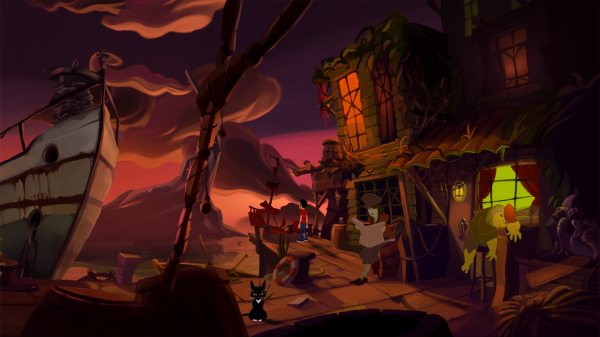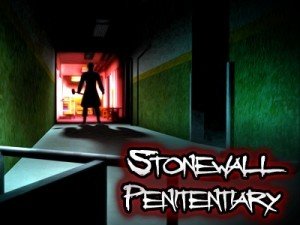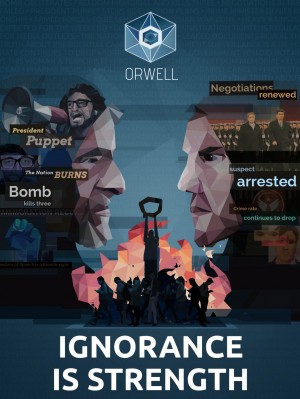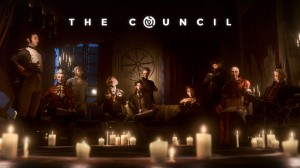Liviu Boar – Gibbous: A Cthulhu Adventure interview

If you're a fan of elaborately produced, gorgeously hand-animated 2D point-and-click adventures, there is a good chance you've known about Stuck in Attic’s “comedy cosmic horror” Gibbous: A Cthulhu Adventure since its successful Kickstarter campaign in 2016. Now that the game's development is nearing completion, we reached out to the Transylvania-based studio to discuss their upcoming debut release. Read on as the team’s Creative Director Liviu Boar sheds light on what is essentially a tribute to both the classics of the adventure genre and the horrors of H.P. Lovecraft.
Ingmar Böke: Hi Liviu, it's great talking to you now that Gibbous: A Cthulhu Adventure is getting so close to release. To get started, please take us back to the past: How did your team originally get together, and how was the idea for Gibbous born? Mixing H.P. Lovecraft and comedy doesn't seem like the most obvious idea.
Liviu Boar: Hey there, thanks for your interest! One of the biggest revelations I had as a kid came while watching someone play Day of the Tentacle. I had dreamed of being an animator, but now I realized you could make cartoons AND games, at the same time! Creating a point-and-click adventure became a life-long goal that I'm finally achieving, 20-something years later.
Our three-person studio came together because of an accident, literally. Myself and Cami, the artistic two-thirds of Stuck In Attic, were working as a tiny in-house animation studio within a bigger IT firm. One fateful day, someone managed to crash into both my car and Nicu's (our programmer). We had been working at the same company but we didn't know each other, and once we got to talking we realized we shared the same dream: making a video game. Vehicular damage, bringing indies together!
It wasn't easy to decide what the game would be about, until I realized that I just needed to make it as fun for myself as possible – just like a puzzle. I took completely unrelated things that I loved – the Cthulhu Mythos, old Warner Brothers cartoons, LucasArts adventure games, ‘40s noir movies, cats – and challenged myself to blend them all into something that felt cohesive. It was so satisfying to see them come together and work as one, and this approach meant that I was able to enjoy every moment spent in the game's universe while making it.
Ingmar: Please introduce us to the story and playable characters of Gibbous.
Liviu: Gibbous revolves around the dreaded Necronomicon, an evil book that is rumored to hold the power of changing reality around itself. Detective Don R. Ketype is on the case to retrieve the eldritch tome, but unsuspecting librarian Buzz Kerwan stumbles upon it and accidentally transforms his cat, Kitteh, into a walking, talking abomination. Being humanized? Quite the downgrade.
Controlling Don and the Buzz/Kitteh duo alternately, you travel the world, deal with strange cults, voodoo, and abominations both cosmic and man-made, all in an effort to turn a very ill-tempered cat back to normal.
It's all about playing as three characters with very different personalities: Don, the grizzled and jaded detective that's seen it all; Buzz, the everyman that serenely puts up with the supernatural; and Kitteh, the feline that is angry at suddenly having to deal with human-like thoughts, feelings, and problems.
You can think of the game as being comedic on a moment-to-moment basis, but with an overarching darker plot that has some genuine thrills, and even some scares.
Ingmar: Your website calls Gibbous a "classically-inspired adventure game with a modern approach." Can you clarify what this statement means in terms of your design philosophy and the game's difficulty level?
 |
Liviu Boar |
Liviu: Gibbous started as a love letter to the games of yore, but we soon realized we wanted to ensure more people could enjoy its story without alienating the genre's hardcore fans. The latter can rest assured that there are a lot of puzzles to be dealt with, both of the inventory and dialogue variety (no sliding tiles or mazes, heh). The game does come with two separate hint systems and other neat features like a hotspot revealer, unlimited saves, and localization into ten languages (for now).
Production value-wise, we've got huge hand-painted HD environments, everything is traditionally animated, all characters are voiced, we've got a weather system, real-time lighting, reflections and dynamic shadows, tons of parallax-scrolling layers... We went all out and took advantage of everything the engine can pull off in 2D. I love the idea that we can have an adventure game sporting the same type of eye-candy that games in other more mainstream genres do.
Ingmar: Do the playable characters have individual abilities that have an impact on gameplay? And do some of the puzzles require cooperation between protagonists?
Liviu: Individual abilities – that's a yes! The main reason we went for the verb-coin interface was that both Buzz and Don have three possible actions: examine, interact, and a special ability. We're keeping Don's special skill under wraps for now, but Buzz's is Kitteh herself – think of how Max works in Sam & Max Hit the Road. However, don't think of her as a mindless automaton always at your bidding: she's got a strong personality, and might even refuse to help unless you provide her with reasonable motivation. Or treats.
There's no cooperative play between protagonists because the game is designed to feel like a TV show: every time a chunk of it is completed, we change perspective and location, and there's a lot of ground to cover, literally. Think Game of Thrones, but with fish-people and talking cats. However, the protagonists do share information, both among themselves and with friends they make along the way – we build this sense of bonding and purpose with the help of animated cutscenes.
Ingmar: There must be an enormous amount of effort behind the hand-drawn 2D graphics and animations of Gibbous. Please give us some insight into the work process behind the visuals.
Liviu: Oh, boy! This part was both the most fun and the most excruciatingly lengthy. There are over 70 fully animated characters in the game. To put that into perspective, each second of animation at 24 fps [frames per second] requires three different drawing passes – that's 72 different drawings for one second of movement.
Example:

There are a lot of different environments in the game, all hand-painted, the biggest one measuring 6000x5000 pixels. Whereas Cami and I split the animation effort halfway, I've had to paint all backgrounds by myself, and the attention to detail resulted in some taking over 40 hours to complete. Our hope is that these huge, lovingly rendered areas with many hotspots to poke at will satisfy even the most exploration-obsessed adventurers.
Ingmar: As your official homepage reminds us, Gibbous is "lovingly made near Vlad the Impaler’s birthplace." How much of Transylvania – real and/or fictional – can be found in the game?
Liviu: Transylvanian nature and architecture are almost everywhere in the game! Not just when you visit Transylvania per se, but also making up most of the Lovecraft-inspired locations, like Darkham and Fishmouth. “Lovecraft Country” equals New England, but we've never been there, so we decided to put our own local twist on everything instead. A lot of ancient, creepy buildings from our small town of Targu Mures stand in as Miskatonic landmarks in the game. We can pompously call it “architectural syncretism”, but really it's just a way of making our environments unique, authentic, and believable. And creepy. Very creepy.
Interestingly enough, Transylvania and Romania do feature in one of Lovecraft's works, The Case of Charles Dexter Ward. It's more of an implied backstory, so I had a lot of fun expanding it and extrapolating a more fleshed-out narrative from it.
We're also taking the opportunity to make fun of the vampire clichés most people are familiar with from old movies, and we're stoked to have local voice actors provide characters with that truly authentic Trrrransylvanian accent.
Ingmar: An important part of your production story is a successful Kickstarter campaign. Looking back, what was your strategy for crowdfunding, and what advice would you give to other indie developers who are considering doing a campaign?
Liviu: There were so many factors contributing to our success, but the very first public outreach we did was towards the AdventureGamers.com community back in late 2014, when very little of the game actually existed. The support and encouragement we got was crucial in gaining enough confidence to take the plunge into full-time development.
Kickstarter is scary, and it seems to be getting tougher to fund games on the platform with each passing year. Luckily, adventure games seem to fare particularly well there, compared to other genres.
I'd suggest that developers show their game as early as possible, and encourage and incorporate feedback. Also, don't ignore your local gamedev communities! We shamefully had no idea so many people from our own country would have our backs until we timidly posted about Gibbous in a Facebook developers group. Most of our backers came from the US, but Bucharest was the #1 city we got pledges from, so keep this in mind and reach out to people near you.
 |
|
|
And finally, Kickstarter is all about transparency. We've tried to keep everyone in the loop all throughout the journey, and we were very honest about everything that went right and wrong with the game – every breakthrough, every new feature, every delay, every reason for said delay. Sometimes we get so caught up in making the game that we take a bit too long to update our backers, but every time we do it we try to make an event out of it. It also helps that we have the best, most supportive and understanding backers in the world. We thank them again for their patience, and assure them it will all be worth it.
We're also very pleased to be able to release Gibbous both on GOG and Steam – you can wishlist the game right now, and we'd really appreciate people telling a friend about us. There is nothing we want more than to keep making games, and for that to happen we need everyone's help to signal boost and help us break through the insane amount of PC games releasing every single day.
Ingmar: What adventure game classics have especially left an impact on you throughout the years?
Liviu: As mentioned before, Day of the Tentacle was my first contact with the genre, and it forever burned the combination of cartoons and interactivity into my brain. It's still amazing to see how much expressivity those magicians over at LucasArts could achieve with so few pixels, not to mention how funny it all is. I still hold that DoTT features the best implementation of time-travel mechanics in any video game, ever.
Sam & Max Hit the Road's excellently implemented sidekick mechanic was a big inspiration when we designed Gibbous. Max also heavily influenced our Kitteh, except she's more condescending than psychotic. I'm a huge fan of Sam & Max's creator, Steve Purcell, and can stare at his art for hours.
Grim Fandango was the first game to make me understand how important world-building is, and its Day of the Dead-meets-Noir theme has been inspirational when it comes to weaving together seemingly unrelated concepts. One of the greatest stories ever told in video games.
And finally, The Curse of Monkey Island is by far the biggest visual influence on Gibbous. The high-res art and animation were jaw-dropping back in the late ‘90s – I couldn't believe that world was actually on my screen, and I could walk around in it. I also loved how Guybrush was always on the verge of being antisocial without crossing into jerk territory – sort of like a videogame Seinfeld. I've done my best to keep that in mind while designing our protagonists, and I hope players will find them endearing despite their flaws.
Ingmar: Old-school classics aside, when you look at the more contemporary adventure games you have seen, which ones stand out for you?
Liviu: So many of them! I'll list a few, along with what I loved about them. Machinarium – for the sheer wordless expressivity; Thimbleweed Park – exceptional puzzle design and great art; INSIDE – one of the most memorable third acts in a game ever; Unavowed – teamwork and a real sense of place; Lamplight City – atmosphere and real detective role-playing; Broken Age – superbly crafted through and through; Paradigm – sheer hilarious insanity; Journey – the first game to ever make me tear up; Darkside Detective – visually striking and hilarious; The Journey Down – lovely characters and production values; Unforeseen Incidents – great story and art; Fran Bow – as beautiful as it is creepy; The Last Door – visually unique, excellent atmosphere... And many others.
Ingmar: There are many games in various genres that refer to the works of H.P. Lovecraft (to varying degrees). What are your personal favorites?
Liviu: I do have quite a few favorites, but reigning supreme among them is Call of Cthulhu: Dark Corners of the Earth. It's the one literary adaptation where the developers somehow reached into my brain and perfectly reproduced Innsmouth and its inhabitants EXACTLY as I imagined them. It's uncanny! Another thing it has going for it is something that we're doing too, and that is weaving elements of several Mythos stories into one cohesive whole. I'd recommend it to everyone who is into atmospheric games... At least until you get to the shooty part.
As almost-straight adaptations go, Shadow of the Comet is cool, but suffers from awkward controls and the tendency to kill you with little warning or reason, which I find very hard to deal with.
A special mention goes to a game that is very dear to me, Quake 1. Discovering Lovecraft after playing Quake, and retroactively realizing that its unique monsters and atmosphere were mostly a tribute to HPL's work, was heartwarming in the most eldritch of fashions.
Ingmar: Getting back to your own game, what kind of length are you estimating?
Liviu: I'm guessing anywhere between 8 to 11 hours – add a few more if you take your time and examine everything (and you can do that multiple times). To put things into perspective, it takes me around six hours just to click my way through it at full speed when testing.
Ingmar: What's left for your team to do before Gibbous: A Cthulhu Adventure is released, and when can we expect the game to launch?
Liviu: We are very close now! We're waiting for a couple of translations and the final batch of voices to be delivered – other than that, the game is done. In the following weeks, once we are content-complete, we'll do a backer beta to make sure we squash any bugs that we might have missed, and we're doing everything in our power to release Gibbous this spring. It's not entirely up to us – working with so many different contractors in different countries with different schedules is very tough on planning, but spring is what we are aiming for.
Ingmar: Good luck with the final stage, and thanks a lot for taking the time for this interview!
Liviu: Thanks! You know that saying, the final 10% is as hard as the first 90%? I didn't want it to be true, but it really is. Cthulhu willing, we'll be unleashing Gibbous on the unsuspecting world very soon. Thanks so much for supporting us, it means a lot! Fhtagn.















